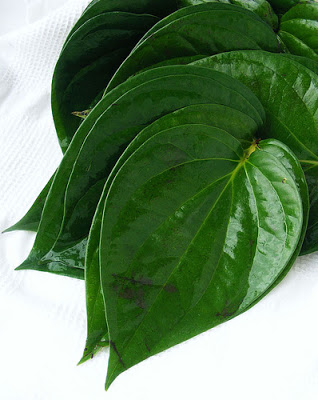Betel
Betel pepper ( Piper betle )
Betel also Betel ( Piper betle ) is a species of the genus pepper in the family of the pepper family ( Piperaceae ). The original home of this species is unknown, perhaps it comes from Malaysia. It is now also grown across the Indian subcontinent and Southeast Asia, where it is Hindi: पान, Pan, "Pan", anglicized also called " Paan ". Its leaves are used in Ayurvedic medicine. In South Asia they are chewed with slaked lime, spices and betel nut.
- 5.1 Notes and references
Description
Appearance and leaf
The betel pepper grows as an evergreen, perennial climber and climbs about one meter high. The creeping, somewhat woolly hairy stem axis has a diameter of 2.5 to 5 mm, forming at the nodes ( more nodes ) rooted out.
The alternate arranged leaves are divided into leaf sheath, petiole and leaf blade. The next sheet-like sheath, called prophyll is about 1/3 the length of the petiole and leaf drop when leaving the prophyll an annular blade scar at each node. The 2-5 cm long petiole is very fine powdery fluffy hairy. The simple, paper-like to more or less leathery leaf blade is more or less symmetrical, with a length of 7 to 15 cm and a width of 5 to 11 cm are usually ovate to ovate -oblong with heart-shaped Spreitengrund, but in the uppermost region of the stem axis sometimes elliptical with rounded Spreitengrund, the upper end is always pointed. The lower leaf surface is densely hairy and glandular there the veins are very fine hairs powdery fluffy. The upper leaf surface is bare. There are seven main nerve, one of which the uppermost pair rises from 0.7 to 2 cm above the Spreitenbasis, the other spring on Spreitengrund. There are clearly recognizable nerve network available.
Inflorescence, flower and fruit
The betel is dioecious getrenntgeschlechtig ( dioecious ). The flowering period extends into China from May to July. The aged men inflorescences arise over the leaf axils. The male inflorescences are almost as long as the leaf blades and their Blütenstandsschäfte are almost as long as the petioles during anthesis. Your inflorescence axis is hairy fluffy. Your bracts are more or less sedentary and at a width of 1 to 1.3 mm, more or less circular, rarely obovate or shield-shaped. The male flowers have two stamens. Their thick stamens are about as long as the kidney-shaped anthers. The female inflorescences having a diameter of about 1 cm and a length of 3 to 5 cm longer than the fruit. Your fleshy inflorescence axis is densely hairy fluffy. The upper permanent ovary is partially enveloped by the inflorescence axis and fused with this. The upper end of the ovary is hairy tomentose. The female flower are four or five free, tomentose hairy scars present.
The drupes are terete, fleshy fruits grown collection that are hairy tomentose at its upper end and stain reddish when ripe.
Use
Betel pepper are available in different varieties whose leaves also differ in taste. Among the best are the betel leaves of the cultivar " Magadhi " ( from the region of Magadha to arise ), which is grown around Patna in Bihar.
Betel leaves are used as a stimulant and antiseptic. In Ayurvedic medicine, they are said to have aphrodisiac effect. In several Southeast Asian countries betel pepper is used as a remedy for headache, toothache, arthritis and joint pain as well as an antibiotic or indigestion use.
In addition to the Ayurvedic medicinal use of plant parts, the leaves of the Betelpfeffers be chewed in India and parts of Southeast Asia as Oral fresh. Among the active substances of the essential Betelöls contained in the leaves are eugenol and eucalyptol as well as terpenes.
These are in betel leaves, slaked lime ( calcium hydroxide) and grated betel nut ( Areca ) - both made into a paste - and a mix of spices (pan masala ) consisting of cardamom, anise, peppermint, coconut and other wound and held together with a toothpick or a clove. There are also additional preparations with tobacco powder and coriander seeds.
The slaked lime keeps the active substances in its basic or alkaline form, thus enabling the sublingual absorption into the blood. The Areca contains the alkaloid arecoline, which causes salivation (which turns red ) and has a self- stimulant. The red juice stains the teeth and damage your gums. Chewing a Betelpriems but has been practiced for several thousand years. While chewing the Betelpfeffers also the DNS is temporarily neutralized in the mouth, which can lead to problems when analyzing saliva samples. Scientists are seeking in such cases, to strengthen the DNA for analysis.
Similar type
Piper sarmentosum is a related type, which is used in cooking and is sometimes called " wild betel ".
Taxonomy
The first publication of Piper betle was in 1753 by Species Plantarum, 1, pp. 28-29.
Swell
- Yung- chien Tseng, Nianhe Xia & Michael G. Gilbert: Piperaceae: Piper betle, pp. 120 - text the same online as printed work, In: Wu Zheng -yi, Peter H. Raven (eds.): Flora of China, Volume 4 -. Cycadaceae through Fagaceae, Science Press and Missouri Botanical Garden Press, Beijing and St. Louis, 1999 ISBN 0-915279-70-3 ( section description)









